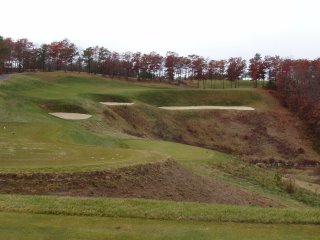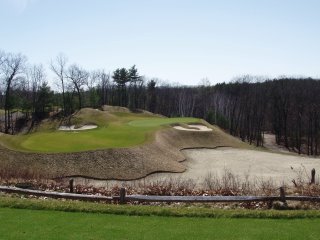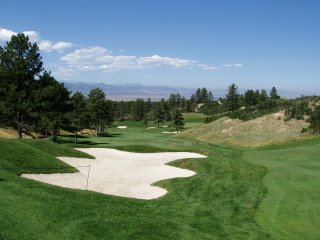I was rattling through all my notes and tapes and found some interview snippets form my 2004 interview with Mike Strantz that I never posted. I hope you like them. I'll have more later this week.
Jay: What is the driving concept you use when laying out your holes?
Mike: Where the land lays. I really spend a lot of time walking the piece of property looking to find the best locations on the site that will result in the best holes. I don’t start with a set number of par-4s and par-5s or whatever. The best combination is what the land decides.
Heidi: [Mike’s wife] The amazing thing about Mike is that he can see it all…that was just dirt, (indicating the northern expanse of Bull’s Bay from the clubhouse). This was a tomato field, this was flat right here.
Jay: How does the land tell you where to put a green complex? Can you give us an example from one of your holes?
Mike: It comes from experience and understanding and reading topography. One good example is No. 2 at Royal New Kent. When I first looked at that topo, I could see the lines, the possibilities, and the cant of the greens, I saw it right away, the way that green would flow.
Jay: Funny you should mention that. That is one of my favorite holes. Am right in thinking that the hole is a little similar to No. 13 at The Dunes - that if you want to go for it in two and you place your tee shot close the edge and then you chicken out then you have a tougher recovery shot to lay up? And if you’re in the correct spot to lay up you have a wider angle to play to?
Mike: Exactly. When you lay up out away from the hazard, you have a better angle to lay up than the guy who is thinking about hitting it in two and then is forced to lay up. I try to do the same thing with cape-style holes.
Jay: Like 4 at True Blue?
Mike: Exactly.
Jay: Let’s talk a little bit about Tobacco Road. Were you influenced by Pine Valley or World Woods or even Prestwick?
Mike: Yeah, it has some of the flavor of certain shots at Pine Valley. I also tried to capture some of the flavor of Merion too, especially the last three holes.
Jay: Like, for example, the tee shot at 18.
Mike: Yeah.
Jay: Now Mackenzie once said no hole was good unless it could be played with a putter. What do you think he would think of that carry off the tee? {Author’s Note: Sources disagree, but many now believe Mackenzie was referring to par-3s.]
Mike: (Laughs and points) He might think it was pretty mild and that I was taking it easy on you!
(much more laughter by all)
Mike: Actually…it would have been a shame if I had filled that in. It was there from the beginning. That pit was right there waiting for me.
Jay: How has Heidi made you better course designer?
Mike: Patience, I used to be very impatient I had to stick with it, I am also very sensitive. It’s human nature. I feel badly when someone might not like or understand one of my courses. Of course, they are welcome to their opinion but it hurts sometimes nonetheless. She’s helped me be more accepting of everything.
Jay: Is it possible that they don’t understand the strategic value of the hole or maybe they are playing the wrong tee box?
Mike: Those are all very true. Those are things that can definitely make someone enjoy the course less.
Jay: I made that mistake at Royal Kent one day…playing one set too long.
Mike: (laughing) That had to be a long day!
Jay: How about Forrest? [Design Partner Forrest Fezler] How as he made you a better designer and in what ways does he get a chance to influence the outcome of the course?
Mike: Forrest is especially good at making sure I don’t get carried away. He will look at me and say “Mike, how is my mom going to play that hole?” His mom is in her 80’s
JF: Can you think of an example?
Mike: Yes. 9 at Tobacco Road. I wanted to build that green much more steeply.
[Author’s Note: While expressing my own personal terror playing 9 at The Road, Forrest noted he didn’t think the hole was all that bad. When I asked him how his octogenarian mother played that hole, he replied “from the forward tees.”]
JF: Tom Doak said that the British and Scottish philosophy is different and better because to them golf is a natural and affordable game and you don’t want to get too pricy…is this a hopeless idea in the United States?
Mike: I hope not…I would like to think not. I mean as a designer you only have a certain amount of control over that, if any at all. I try to alleviate that by keeping maintenance costs down as much as possible. Also, they have more fun playing, they appreciate design a great deal and they are not worried about blind shots. In America we have to loosen up a bit.
Jay: Now what are some of your favorite designs over there that you recommend that might be a bit off the beaten track?
Mike: Well I love Royal County Down of course, and hang on, there’s an old favorite of mine that’s really obscure…I can’t think of the name (looks around for a minute)
Jay: Which country is it in?
Mike: Scotland
Jay: Machrahanish?
Mike: No…that’s a good one too, though. Another of my favorites but hang on…it begins with a g?
Jay: Begins with a G?
Mike: Yeah
Jay: Gullane?
Mike: Gullane!
Jay: I’ll take obscure Scottish courses for $1,000, please Alex.
(more laughter)
Jay: While we are talking about those courses, tell us how do you play your matches with your Northern Irish friends who may come over here or when you come over there?
Mike: Totally different….we play the 2-1/2, 2-1/2, 2-1/2 game. I bring my friends over there one year, they come here the next
Jay: What’s the 2-1/2 game?
Mike: You take 2-1/2 hours to play 18 holes in the morning….you eat and drink for 2.5 hours, then 2-1/2 to play 2-1/2 hours to play 18 holes in the afternoon.
Jay: So it’s really 2.5 hours of playing and 2.5 hours of drinking and 2.5 more of playing.
Mike: (laughs) Yeah.
Heidi: Don’t they do those 24 hour golf games too?
Mike: Yeah, they last till about 10 or 11. It stays light till about 10 or 11 at night there in the summer. Its great. You’ll see retired veterinarians walking with their dog tied to a bag. Bear his name is…
Heidi: The dog, you mean? Or the doctor?
Mike: The dog.
Jay: Let’s have a little fun for a second….I am crossing my fingers that you did have something to do with this or can remember it…let’s go back to the 1979 U.S. Open. Tell me what you know or remember about that Hinkle tree.
Mike: I planted that tree! I’m the guy on the tee box that night backing in the trucks! I tried to tell them they needed to move it a little bit, but…(laughs)
Heidi: We have old photographs from the Detroit Free Press around somewhere.
Jay: Did you put the “Hinkle Tree” sign on it?
Mike: That was USGA. I was rolling my eyes. But while I am not one to take playing options away from people, that was not a real option.
Heidi: Not a good option.
Mike: Well not that it's not a good option, but not what was intended, you need to have as many options as you can, but that…(laughs)
Jay: What drives you the most crazy about playing other courses?
Mike: Well first, if you can’t play well, play fast. Next, I don’t like golf courses that are dictatorial. I like options. Like National Golf Links and Shinnecock.
Heidi: Wow. Dictatorial. That’s a five dollar word for a golf course architect!
(more laughter)
Mike: (excited) You can count out your angles at National, there are so many ways to attack the course, it’s like gold to a golfer! It’s only 6,800 yards, but you can’t just automatically step up and hit driver.
Jay: What’s your position on the technology debate.
Mike: I am not much worried or affected by that. Such a small fragment of people can do that with a golf ball that it doesn’t really apply to the rest of us.















